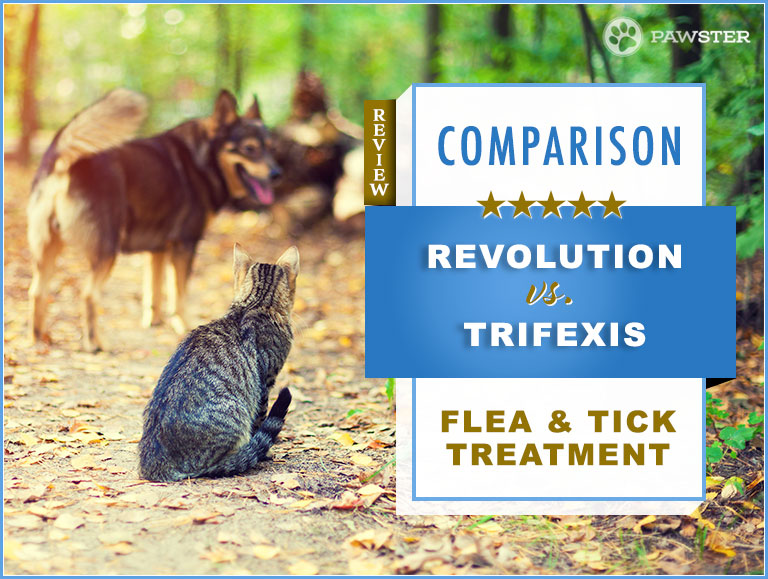Revolution vs. Trifexis : 2024 Comparison and Key Differences

Contents of Article
In terms of broad-spectrum treatments for common pet parasites, two names come to mind: Revolution and Trifexis. They both treat internal and external parasites. They’re both quality treatments, and both require a prescription.
The real question, however. Do you want a chewable or do you want a spot-on treatment? Both have advantages and disadvantages. A spot-on treatment is what people are familiar with, but a chewable could change the game for you completely. How do you know what to do?
Let’s break it all down to figure out which treatment method is the right one for you.
Which is Better Revolution or Trifexis for Dogs?
We are big fans of treatments that don’t require a topical solution. They’re fast, easy, and you don’t have to separate your pets from each other or your children while the treatment absorbs. Trifexis has both the parasite coverage and the ease of use we’re looking for in a long-term pest prevention plan.
For most dogs, Trifexis will handle internal and external parasites in a single, chewable dose. Some dogs may not like the taste, and some may be sensitive to internal treatments for parasites. In this case, you might be better off with a spot-on. However, in most cases, we think that the ease of use for Trifexis is better for your situation.
Which is Better Revolution or Trifexis for Cats?
We also love an oral preventative for cats. Cats are notoriously difficult to use a spot-on treatment for, so if you don’t have to deal with it, we wouldn’t. Unless your cat has stomach issues that prevent it from using an oral preventative, we’d definitely go with the Trifexis.
If your cat cannot take Trifexis chewable, we have some recommendations below for how to make the most of a spot-on cat treatment.
Our Review of Revolution and Trifexis
There isn’t much about these two solutions that they have in common. Both will require a prescription, so make sure you visit your veterinarian. They both contain medication to handle heartworms, ringworm, hookworms, plus external parasites such as fleas and ticks.
Both doses cover your pet for a month following application.
Key Differences Between Revolution and Trifexis
Although the end result is the same, Revolution and Trifexis don’t that much in common.
Method Of Delivery
Revolution is a once monthly spot-on treatment. It comes in a tube that helps part hair down the middle, so you can get the solution close to the skin where it can absorb. It’s waterproof but not right away, so you’ll have to give your pets some time indoors and away from water, so you don’t compromise the application.
Trifexis is a once monthly chewable. It comes in a beef-flavored chew that mimics a treat. Pets shouldn’t have any trouble taking the chewable, and you should see a reduction in fleas within hours.
Age
Revolution is suitable for all dogs ages 6 weeks and older. It’s safe for cats as young as eight weeks. Both can be used for pregnant, lactating, and nursing animals, but be sure to check with your veterinarian beforehand.
Trifexis can be used from eight weeks and above, but your dog should also be five pounds or over. You should ask your veterinarian before giving it to any pregnant or nursing pets because the literature on using Trifexis for this category is still inconclusive.
Revolution and Trifexis Active Ingredients Comparison
Both rely on neurotoxins to handle external parasites and internal ones. The specific ones are different, however, and the neurotoxin doesn’t affect your pet’s system in any way. It shouldn’t cause any trouble if you come in contact with the product although you’ll want to make sure your children don’t have contact with it.
Trifexis: Selemectin
Selemectin is a neurotoxin that affects parasites internally. It prevents them from feeding and completing the breeding process. It’s incredibly versatile and fast acting with 90% control of fleas within the first month. It has relatively few side effects, but some could be diarrhea, vomiting, or stomach issues. Be sure to check with your vet if anything seems out of the ordinary.
Revolution: Spinosad/Milbemycin Oxime
Spinosad is a naturally occurring compound in the soil. It also interrupts the feeding and breeding cycle of the pest. Milbemycin Oxime controls heartworms and other parasitic worms like hook or roundworms. Some common issues could be skin irritations and reactions but check with your veterinarian if anything seems unusual.
As with any topical ingredients, Spinosad can cause irritation if it gets into your eyes or mouth. That goes especially for children. Although it’s a naturally occurring substance, you should still make sure to wear gloves and keep your child away from the treatments just after you give it.
Which Treatment is the Best Priced?
Revolution is slightly cheaper than Trifexis. For six doses you can get Revolution about $10 cheaper overall than Trifexis. They both require prescriptions, so that’s a wash. Also, they both cover most of the same pests. However, Trifexis has no effect on ticks. Revolution does put a few dollars back in your wallet, but the ease of use in Trifexis may make up the difference.
Which Do We Recommend?
We prefer Trifexis for a few reasons. First, the delivery method is a lot more convenient than a spot-on treatment. It doesn’t require a separation period between pets right after application. It doesn’t require exercising your dog to make it calm enough to apply the solution.
We also like that there’s no mess and no fuss. The chewable tablet is simple to administer, and most pets love the flavor. They shouldn’t fight it as much as they potentially do a spot-on treatment.
We also love that there’s nothing to wear off or get all over us. It doesn’t need separations, and you won’t worry about your children accidentally getting it on their hands. It’s the smallest bit more expensive, but overall, we think the extra cost is worth it.
The only time we’d recommend Revolution is if your pet has dietary needs that prevent it from receiving the chewable. Also, if your pet is one of the rare ones that can’t stand the chewable, Revolution may be your only option. The size of your pet could prevent a Trifexis dose as well.
Aside from those narrow instances, we think Trifexis is an easier, more straightforward preventative that covers a wide range of external and internal parasites. For us, a chewable will win out almost every time.
7 Treatment Application Tips
Chewables and Spot-on treatments each have their own quirks. If you’ve never used a chewable or if this is your first time treating a pet for parasites, you may be at a loss for where to start. Here are a few tips for applying and administering your preventative of choice.
Chewables:
- If your pet doesn’t like the taste of the chewable, or if your pet is nervous (because pets are good at reading body language, right?), there might be some things you can do to make it easier. One of our favorite methods is the “sandwich” method. We get our pet’s favorite treat and make sure it can smell the treat. We give one treat and then the chewable. Right after, we offer another treat. Sometimes, our pet is so focused on the favorite treats, it eats the chewable right away without fussing.
- Cats can be trickier. If your cat regularly eats all its meal, you might try chopping up the chewable and putting it in your cat’s food. Be sure you don’t do this if you leave food out all the time or your cat doesn’t eat all its food. You may not be sure if your cat has taken the entire dose.
- If your pet has an adverse reaction to the chewable, even if it’s totally natural, you may have a difficult time giving the next dose. Make sure you don’t change foods or introduce any new treats before giving the chewable. If your pet has an adverse reaction, you’ll know it was the chewable and not something new in your pet’s diet. Be sure to talk to your vet about giving the chewable the first time so that he or she can give you directions for how much food and water to provide with the chewable.
Spot-On Treatments
- Exercising your pet thoroughly before applying a spot on treatment can help things go smoothly. Go on a long walk or play your pet’s favorite game for at least 30 minutes. Expending extra energy can help your pet stay calm and still. Once they’ve gotten sleepy and calm, you should be able to apply the solution without having to fight too much. This can also help if you’ve got to keep pets separated after applications. They should go right to their kennels or sleeping spots.
- If your cat just isn’t having the spot on treatment, you might want to try a kitty muzzle. For some reason, many cats become a lot calmer if their eyes are covered. A kitty muzzle goes over your cat’s eyes without interfering with breathing. You can treat your cat without too much fuss. Once the treatment absorbs, you can release your cat.
- Don’t bathe your pet for at least two days before and after the spot-on treatment. The natural oils in your pet’s coat help the treatment disperse. Washing your pet too soon before the treatment can dry your pet’s skin and coat and cause some mild irritation from the treatment. It’s also essential that you not bathe your pet directly after the treatment because it needs time to become fully waterproof. You risk removing some of the solution by introducing water to the coat too soon.
- Don’t be tempted to leave indoor animals untreated. You can always bring in fleas and ticks yourself. Plus, dogs that go out for the bathroom even for a minute are still at risk. Indoor cats can pick up fleas and ticks from doorways or other areas where insects can find their way in. Treating your pets can help you keep accidental infestations down.
Final Thoughts
Choosing between a chewable and a spot-on treatment is a difficult choice. We favor the chewable because it simplifies the whole process of treating your pets for both heartworms and external parasites. The chewable won’t get all over your hands and won’t wear off accidentally.
Setting reminders for the monthly dose can help keep you keep up. Also, some vets will offer automated reminders through their network. If this is something your vet offers, we definitely recommend taking it because the less you have to remember the better. Get that chewable and stop worrying.
On a scale from one to ten, how easy is it for you to give your pet its pest preventative? Let us know in the comments below.






